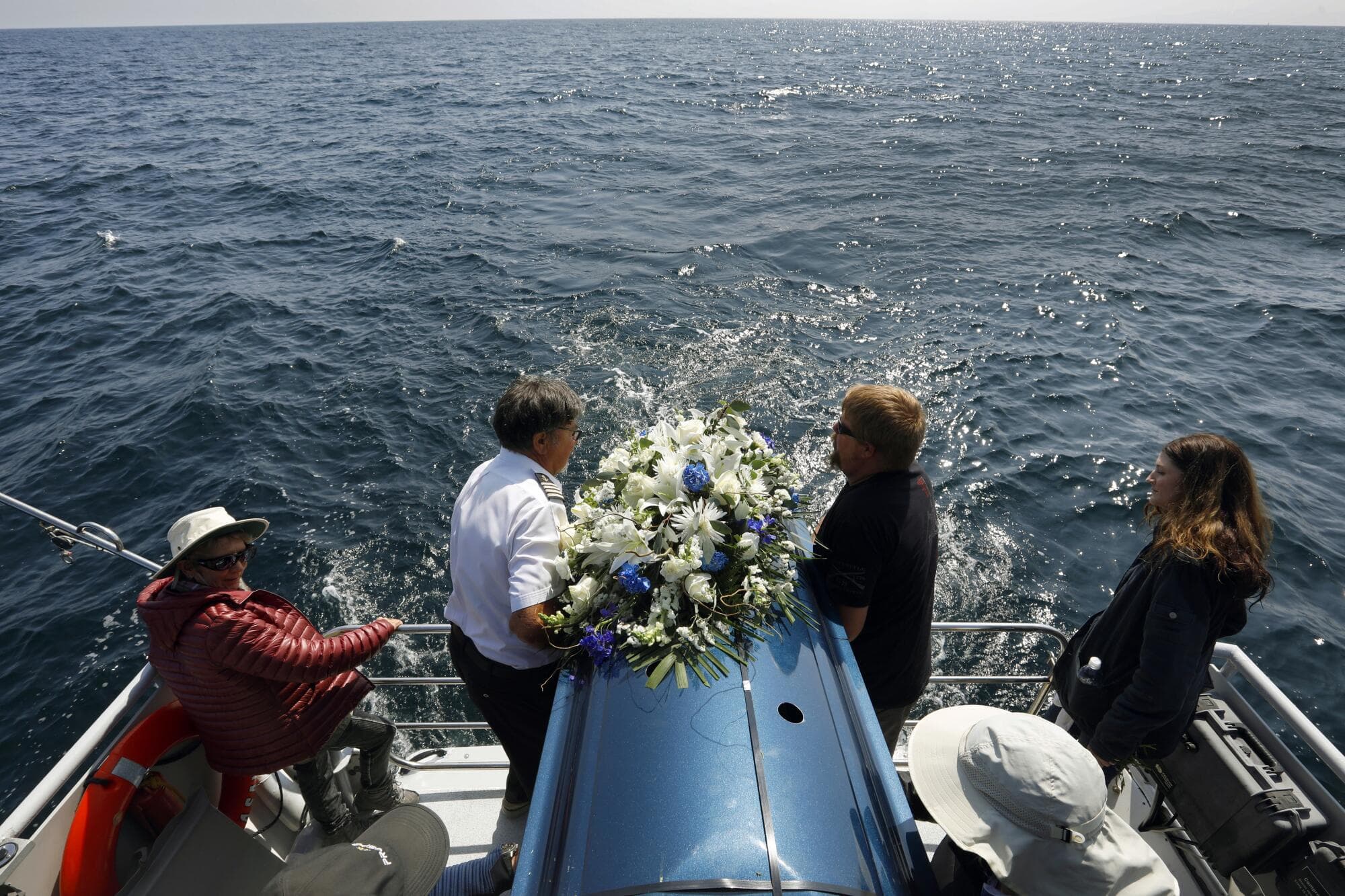Memorial Service
Memoria's Guide to Burial at Sea
Discover the Complete Guide to Arranging a Burial at Sea - From Permits to Ceremonies. Learn How to Honor Your Loved One's Final Wishes. Explore Our Expert Tips Now!

For some, there's a certain allure to the idea of a burial-at-sea that is both poetic and liberating. The vast expanse of the open ocean, with its boundless horizons and unpredictable tides, offers a final resting place that transcends the constraints of traditional cemetery plots. It symbolizes a return to nature, a merging with the eternal cycle of life and death, where one's remains become part of the ever-flowing waters. This unique form of farewell provides a sense of serenity and connection with the elements, allowing loved ones to find solace in the idea that the departed have embarked on an eternal journey, free from earthly limitations. It's a choice that carries a certain mystique, honoring a sense of adventure, a love for the sea, and a desire for a departure that mirrors the vastness of the human spirit.
1. Where does Burial at Sea come from?
Burial at sea has a rich cultural history and can be traced back to various civilizations and cultures around the world. Here are a few examples of cultural evidence of this practice:
1. Ancient Maritime Cultures: Throughout history, many maritime cultures have practiced burial at sea. The ancient Greeks, for instance, believed that this form of burial was a way to appease the god Poseidon, ruler of the sea. The Vikings, known for their seafaring ways, were also known to commit their deceased to the sea in elaborate ship burials, symbolizing a voyage to the afterlife.
2. Naval and Maritime Traditions: Many naval traditions involve burials at sea. The practice is especially prominent in the military, where deceased sailors and mariners have been buried at sea as a sign of respect and to ensure their souls find peace. The U.S. Navy, for example, has a long-standing tradition of burial at sea, complete with specific protocols.
3. Hindu Burial Rites: In Hindu culture, there is a tradition of immersing cremated remains in the sacred rivers like the Ganges. This can be seen as a form of burial at sea, as the ashes are released into the flowing water, symbolizing the cycle of life, death, and rebirth.
4. Traditional Fishing Communities: In many coastal communities, especially in Southeast Asia, traditional fishing communities have practiced sea burials for centuries. It's often seen as a way to give back to the sea, which provides their livelihood and sustenance.
5. Modern Practices: In the modern era, burial at sea is still an option for some individuals who have strong connections to the sea or maritime professions. Various countries have regulations and procedures in place for conducting burials at sea, often involving a ceremony on a ship before the deceased's remains are committed to the ocean.
These examples highlight the diversity and historical significance of burial at sea across different cultures and time periods. It continues to be a meaningful and culturally significant practice for various groups, both as a symbolic and practical way to honor the deceased and their connection to the sea.
At Memoria, we believe that understanding the depth and nuances of burial at sea is essential. It's not just about the act itself but about the emotions, beliefs, and traditions that underpin this choice. As we navigate the waters of remembrance, our aim is to ensure that every sea burial is conducted with the utmost respect, dignity, and reverence for both the departed and the timeless oceans that embrace them.
2. Types of Sea Burials
The vastness of the ocean offers a range of possibilities when it comes to laying a loved one to rest. Each method of sea burial carries its own unique significance, rituals, and considerations.
Full Body Burial: This method harks back to ancient maritime traditions. The deceased is placed in a specially designed casket, crafted to be environmentally friendly and respectful to the marine ecosystem. The casket is then solemnly lowered into the sea, ensuring it sinks quickly and remains submerged. This offers a dignified, eternal resting place amidst the ocean's depths, allowing the departed to be embraced by the vast expanse of the sea.
Ash Scattering: For those who opt for cremation, scattering the ashes at sea presents a poignant way to merge the essence of the loved one with the waters. The ashes, released into the ocean, become one with the currents, waves, and tides. This symbolic union represents a return to nature, a connection to the world's waters, and a tribute that flows with the eternal rhythms of the ocean.
Choosing the right type of sea burial is a deeply personal decision, influenced by various factors, including the deceased's wishes, family preferences, religious beliefs, and cultural practices. It's a choice that intertwines the tangible act of interment with the intangible emotions of love, remembrance, and reverence.
3. Choosing the Right Location
The vast expanse of the world's oceans, seas, rivers, and lakes offers countless locations that can serve as the final resting place for a loved one. However, the choice of location for a sea burial is more than just a geographical decision; it's deeply intertwined with emotions, memories, and the legacy of the departed.
For many families, the location holds a special significance. It could be a serene spot where the deceased often found solace, perhaps a beach they frequented or a stretch of coast that resonated with cherished memories. For others, the choice might be influenced by the sheer beauty and tranquility of a location, offering a peaceful and picturesque backdrop for the burial ceremony.
Beyond the emotional considerations, there are practical aspects to keep in mind. Different bodies of water have varying regulations and guidelines related to sea burials. It's essential to be aware of these to ensure that the act is conducted respectfully and in accordance with maritime laws. Factors such as water depth, distance from the shore, and marine traffic can also influence the decision.
4. Ceremonial Aspects
Every life is a tapestry of moments, memories, and connections. When commemorating a loved one through a sea burial, the ceremonial aspects play a pivotal role in capturing the essence of their journey and the bond shared with them. These ceremonies, set against the vast backdrop of the ocean, offer a unique blend of tradition, personalization, and deep emotion.
A sea burial ceremony can be tailored to reflect the beliefs, values, and wishes of the departed and their family. Traditional rituals, readings, and prayers can be incorporated, drawing from religious or cultural practices that held significance for the deceased. Music, often chosen for its resonance with memories or the individual's preferences, can add depth and poignancy to the ceremony.
Additionally, symbolic gestures, such as the release of flowers, wreaths, or even biodegradable lanterns, can be integrated. These acts not only enhance the visual beauty of the ceremony but also offer attendees a tangible way to express their grief, love, and farewell.
5. Legal and Environmental Considerations
The profound act of laying a loved one to rest in the embrace of the sea is intertwined with a set of legal and environmental considerations. These guidelines and regulations ensure that the burial is conducted with the utmost respect for both the marine ecosystem and maritime laws.
Different regions and countries have specific regulations surrounding sea burials. These can pertain to the distance from the shore, the depth at which burials or scatterings should occur, and the type of materials permitted for use, especially in the case of biodegradable urns or caskets. It's essential to be well-informed about these regulations to ensure that the ceremony aligns with legal requirements and avoids any unforeseen complications.
From an environmental perspective, the sea is a delicate ecosystem, home to diverse marine life. The choice of biodegradable materials and adherence to guidelines ensures that the burial has a minimal impact on this ecosystem. It's a way to honor the departed while also showing reverence for the natural world.
6. The Emotional Journey
The act of saying goodbye to a loved one is an emotional voyage, filled with a myriad of feelings ranging from sorrow and loss to reflection and gratitude. Choosing a sea burial adds another layer of depth to this journey, intertwining the vastness of the ocean with the vastness of human emotions.
The sea, with its endless horizons and rhythmic waves, often mirrors the emotions of those left behind. Just as the tides ebb and flow, so too do feelings of grief, love, and acceptance. The act of entrusting a loved one to the embrace of the sea can be both therapeutic and overwhelming. Watching as the ashes disperse into the waters or as a casket descends into the depths can evoke a powerful sense of release, symbolizing the letting go of physical ties while holding onto cherished memories.
For many families, the sea becomes a place of solace and reflection. The gentle lapping of waves, the call of seabirds, and the vast expanse of blue can offer a sense of peace and continuity. It's a reminder that while life has its endings, the bonds of love and memory are as enduring as the oceans themselves.
However, it's also essential to recognize that each individual's emotional journey is unique. While some may find comfort in the act of a sea burial, others might grapple with feelings of distance or the intangibility of not having a fixed memorial spot to visit.
7. Memorializing After a Sea Burial
While the sea becomes the final resting place, the need to remember, honor, and celebrate the life of the departed often extends beyond the ocean's embrace. Memorializing after a sea burial offers families tangible touchpoints to revisit memories, share stories, and ensure that the legacy of their loved one remains vibrant and present in their lives.
Land-Based Memorials: Even after a sea burial, many families choose to establish a dedicated memorial spot on land. This could be in the form of a memorial bench overlooking the sea, a plaque in a cherished location, or even a dedicated tree in a memorial garden. Such spots provide a physical location for families to gather, reflect, and commemorate special occasions or anniversaries.
Artistic Tributes: The inspiration drawn from the sea and the memories of the departed can be channeled into various forms of art. From paintings that capture the essence of the ocean to sculptures and installations that resonate with the individual's personality, art offers a lasting tribute that can be admired and shared with future generations.
Digital Memorials: In our increasingly digital age, online memorials have gained popularity. These platforms allow families to create dedicated pages, complete with photos, stories, and tributes, ensuring that the memory of the loved one is accessible to friends and family worldwide. It's a space where memories can be shared, stories can be told, and the community can come together in remembrance.
Keepsakes and Jewelry: Small mementos, like jewelry infused with a trace amount of the departed's ashes or keepsakes inspired by the sea, offer a personal and intimate way to keep the memory close. Every time these items are worn or held, they serve as a silent conversation, a touchpoint to the past, and a testament to enduring love.
8. Practicalities
Undertaking a burial at sea can pose significant challenges in terms of time, expense, and complexity, primarily due to the stringent regulations imposed by the U.S. Environmental Protection Agency. These guidelines apply to both whole-body burials at sea and the interment of cremated remains.
Human remains shall be prepared and buried in accordance with accepted practices and requirements as deemed appropriate by authorities responsible for the arrangements.
Burial of non-cremated remains shall take place no closer than three (3) nautical miles from land and in water which is not less than six hundred feet deep.
All steps should be taken to ensure the physical remains sink quickly (and permanently) to the bottom.
Cremated remains shall be buried without regard to depth limitations; however the three (3) nautical mile limit from shore remains in effect.
Flowers and/or wreaths must be readily decomposable in this marine environment.
All sea burials (whether of cremated remains or of the whole body) shall be reported within thirty (30) days to the EPA Regional Administrator of the region or locality where the vessel departed from shore.
For additional information on Environmental Protection Agency regulations governing sea burials, we encourage you to visit their website.
How to get started with Burial at Sea
Here's how to begin the process of arranging a naval sea burial: call us at (929) 295-4401 It's that easy; we've had considerable experience dealing with government agencies responsible for the performance of military honors at funerals and memorial services, and burials-at-sea. We will need the involvement of what the government calls the PADD, or "Person Authorized to Direct Disposition" (usually a family member, identified on the basis of the accepted order-of-precedence who is responsible for service and disposition arrangements–or the individual noted in a Record of Emergency Data form).
Together we will complete the requisite paperwork, and provide all required supporting documents, including:
A photocopy of the death certificate
The burial transit permit or the cremation certificate
We will submit the completed packet to the proper authorities on your behalf, and handle all the logistical details.
Following the passing of a beloved family member, you need not experience feelings of isolation, solitude, or lack of support. We are here to provide the essential guidance and assistance to you and your family during this time.


